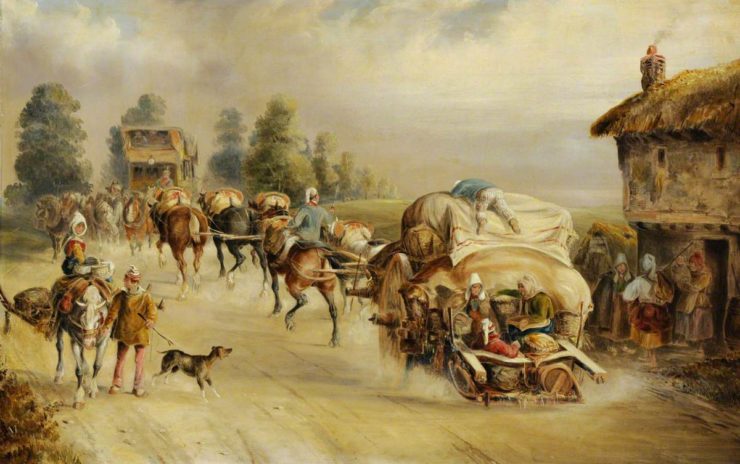Usually when I hear about coevolution of humans and animals, it’s in reference to dogs. Wolves came to the fireside, the story goes, and humans fed them and got their services in return as hunters and guardians. There’s a strain of thought that says it goes further than that: that human cooperation is modeled on the pack structure of the canid. I’m not sure I’d go that far, but for a writer it’s an interesting thought experiment.
So what about horses?
Dogs live in the house or tent or cave with the human; they’re interacting constantly, and affecting each other directly. Dogs are also much smaller, more portable, and easier to maintain in a subsistence society. Horses need a lot of land, a lot of fodder, and a lot of maintenance compared to dogs. That’s not something that everyone can manage. All social levels may associate with dogs, but horses have tended to gravitate more toward the privileged classes.
That’s one reason, I think, why the idea of bonding with a horse has tended to wander around outside the mainstream. Fewer people know horses than know dogs; and even those who know horses may be too busy using them as work animals or status symbols to notice that they have their own distinctive intelligence. The dog by the fireside is making his personality known early and often. The horse in the barn or the pasture, pulled in to work and then put back out again, may not be able to get a word in edgewise.
But bonding isn’t all there is to coevolution. Coevolution is mutual change. Through their interactions, the two organisms alter the way they grow, look, act, or function.
And that’s where it can be argued that of all animals that humans have associated with, the horse has had the strongest influence. Dogs have long been helpers, guardians, herd managers—but horses, prior to the invention of mechanized transport, gave humans a level of mobility that they had never had before. The horse, ridden or driven or brought along as a pack animal, expanded humans’ range tremendously; it gave them the ability to mount much larger migrations, extend their trade to much more distant areas, and carry many more goods and treasures.
It also made war a much more efficient and effective operation. The charioteer or the mounted warrior could travel faster and farther, and carry more and deadlier weapons. It’s hard to deny, based on what evidence we have, that the horse kicked the history of violence up a good number of notches.
Which is ironic in its way, because while horses can be extremely aggressive toward each other, as a species they thrive on cooperation. Stallions fight to defend their herds. Mares fight to protect their young and each other, and to get a larger share of available food. But for the most part, they cooperate. They band together against predators, they follow their senior members to food and water. “Aunties” and fathers (yes, stallions are good fathers) help raise the young.
I think that cooperative streak is what led the horse to tolerate domestication in the first place. The link above gets all dewy-eyed about a girl and a stallion, but I’m much more inclined toward the view that the first ridden horse was an old broodmare who had been climbed all over by the stallion and her offspring; an adventurous human, probably young and fairly lightweight, would hardly faze her. Stallions on the other hand do Not like things on their backs—because those things would, in nature, be either another stallion in a fight, or a mountain lion looking for dinner.
Whatever actually happened, or when or where, there is no possible doubt that it happened. Horses became one of the most important animal partners of the human species, and human history changed. The next change that would have that much effect on humans would be the rise of mechanical technology—and that one would render the horse obsolete.
Or would it?
Horses are still important in remote parts of the world; they can go where mechanical transport can’t, and can carry equipment and supplies as well as humans. But that’s a serious comedown from the time when the main mode of transport was the horse.
Still, in spite of his having been superseded almost completely by machines, the horse is nowhere near extinct. He’s moved noticeably in the direction of the dog, which also has receded in importance as a working animal, but which continues to be a popular and cherished companion.
The horse as companion animal can’t be a new concept, but it has become a great deal more prominent since he stopped being the main source of transport. Larger numbers of humans are realizing that the horse is an intelligent creature, generally well disposed toward humans, and willing to accept them as herd members if they come at it in the right way. There’s still plenty of use and abuse, and far too many horses misused or mistreated, but more humans also seem to be trying harder to see the horse’s side of things.
Humans and horses, in short, are still coevolving. While horses’ effect on the larger course of human history is probably over, their effect on individual humans is, if anything, stronger than ever.
Judith Tarr’s first novel, The Isle of Glass, appeared in 1985. Since then she’s written novels and shorter works of historical fiction and historical fantasy and epic fantasy and space opera and contemporary fantasy, many of which have been reborn as ebooks. She has even written a primer for writers: Writing Horses: The Fine Art of Getting It Right. She has won the Crawford Award, and been a finalist for the World Fantasy Award and the Locus Award. She lives in Arizona with an assortment of cats, a blue-eyed dog, and a herd of Lipizzan horses.










